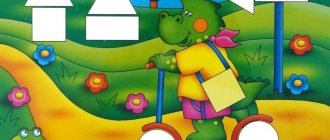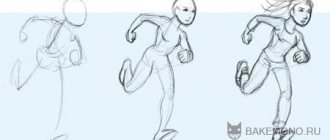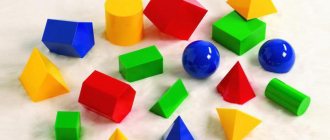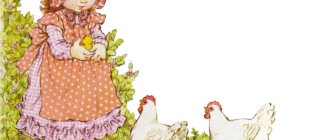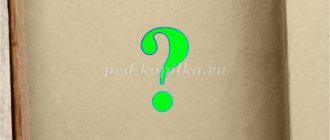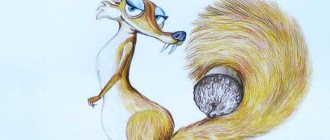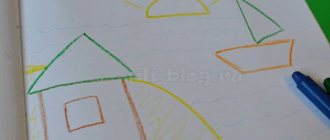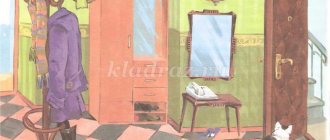Lesson notes for educators and teachers
Topic: Geometric shapes
Goal: To consolidate concepts about geometric shapes. Summarize knowledge about the properties of shapes
(color, size). Strengthen ordinal counting within 10. Enrich your vocabulary.
Develop logical thinking, tactile and long-term memory, proper breathing, listening skills, fine motor skills.
Cultivate accuracy and self-control.
PROGRESS.
Psycho-gymnastics.
-Look how many guests have come to us, say hello to the guests. -Sit more comfortably on a chair, close your eyes and listen - how is it in our office? Quiet or loud?
-Now close your eyes and listen to what is happening behind the door. - Loud, why loud?
-Someone is knocking on our door, someone is probably late for our lesson. Let's invite a guest.
-Look, this is a box, what geometric shape does the side of the box resemble? And this?
A box with something written on it. -Let's read it! Can you help me?
- Parcel for Maxim.
- Who is Maxim? So this is for you. Let's see what's inside it. -This is a package of tasks and we need to complete them.
Envelope No. 1
-There are geometric shapes in the envelope, name them.
-Using the same figures, you can create new geometric
figures.
-Attach these figures first. Then, without looking into the bag, by touch find the figures that I will name.
-Well done, you completed the task! Let's move on to the next task
-Take the envelope with the number 2 written on it.
Envelope No. 2
-What do I have? This is a frame. What shape is it? What geometric shapes does it consist of?
-Now we will make a square from different figures. What color is the square, what shapes did you make it from, how many corners, how can I say it differently?
- Well done, you did it. Let's put our squares in the parcel.
-Now what number is the next envelope?
Envelope No. 3
-Look what's in the envelope? We need the lace for the next task.
-After all, with the help of geometric shapes, you can not only create new shapes and assemble the shapes themselves using different ones. But the objects of our life themselves symbolize geometric shapes. Now, we need to match the figure with the object using laces.
-Well done! Let's move on to the next task. Envelope with number 4
Envelope No. 4
-What is this? What do we need the tube for? You can also breathe into it.
-You will blow into the tube so as to roll the ball to the top and hit
hole.
Envelope No. 5
-Here we have drawn figures, you need to draw them with the help of a ball, but at the same time close your eyes.
-Well done!
Envelope No. 6
-We have a marker. And we need to solve examples.
-I really liked the way you solved the examples.
-Let's see what we have in the next envelope under the number 7
Envelope No. 7
And we have geometric shapes. Tell me we can make something out of
these figures. Build what you want.
What or Who did you depict? What else can be built?
And what's in the last envelope? What number...
Envelope No. 8
And here is a cutaway picture. Let's collect it. And we will have the task on the computer.
- Help the car get to the house by choosing the correct path from the shapes
- Help the car get to the house by choosing the correct path by color.
- Look at the lights of the house and remember them. Now put them the way they were for me.
4. Tell me what time of year it is? It's cold outside and icicles will appear soon. I already have icicles, I just need to paint them.
Result: name the figures we talked about. Which group can we unite into? What is another name for them? What are these figures?
Maxim, look at our parcel - it has become a great parcel of your knowledge.
Source: https://konspekty-zanyatij.ru/uchebnye-materialy/konspekt-zanyatiya-po-femp-v-starshej-gruppe-geometricheskie-figury/
Learning geometric shapes with kids in preschool educational institutions
When studying geometric concepts, children also gain other knowledge and skills in parallel:
- they learn to think logically;
- get the opportunity to develop knowledge of the Russian language;
- the perception of space and the ability to navigate in it improves;
- children develop fine motor skills;
- Intellectual qualities develop: the ability to make comparisons, analyze, and generalize.
Note! When teaching in kindergarten, the development of geometric concepts is not highlighted as a separate topic, but occurs in combination with other topics.
Children learn geometry
Learning colors and shapes for children from 2 years old
Geometry learning should begin with the simplest figures; more complex ones should be left for subsequent years. It is believed that children are able to perceive shape on a subconscious level within six months after birth. At this time, the main way of teaching is through mention during the story. When showing pictures, you can casually notice that the objects depicted have a certain shape.
When teaching, you need to take into account that kids can only learn to distinguish between the simplest ones: circle, square and triangle.
Note! Studying in a year or two or three should be easy and fun. For mastering it is convenient to use three-dimensional figures. Studying, for example, a circle, you can imagine that he came to visit the baby. You can use your child's finger to trace a circle along the outline. You can make such an applique, decorating it with eyes and a nose.
Drawing lessons on the theme “Airplanes are flying” for the middle group
A child can play with this item: make a tower by placing one on top of the other, throw it to the side or put it in a box.
This integrated approach to a geometric design project is very effective for toddlers, but for younger children it can be considered the primary way to learn shapes.
For children under two years of age, the following may be used:
- children's ability to compare objects;
- use a children's educational set, where you need to select a hole of a suitable shape and size for the figurine.
A two-year-old child is able to choose the appropriate shape from a set.
When they teach figures to 3-year-old children, they can already show the one that was named by the teacher.
Learning figures for children 3 years old
When teaching children geometric shapes, it is important to consolidate familiarity with the material that they have previously learned. We need to continue studying and move on to those that are more difficult to understand - oval, rhombus and rectangle.
When teaching children, you can show children examples of figures, letters of the alphabet and compare them with other objects in shape and size.
Important! During the walk, children are told about the objects they see, mentioning their shape and simple geometric properties.
An important role when teaching geometric shapes to children is played by creative activities, when children draw or sculpt samples and put them together from a given set of component parts.
Using cards depicting complex objects, the child is asked to talk about the components in the form of certain shapes.
Children education poster
Geometric shapes in the senior group
At this time, the lessons move on to considering new, more difficult to understand figures, repeating those that they should have known before.
In classes at the age of five, children are asked to consider and talk about their common and different properties. For example, questions are asked about where open figures have corners and in which cases they do not.
They try to teach children to analyze the complex shapes of real objects, to find elements in them that have the form of simple figures. They learn about more complex shapes, such as a cone.
Geometric shapes in the preparatory group
At this age, children have already mastered the basics of understanding the shapes of objects. At this stage, it is important to develop knowledge and make it more systematic. At this age, children develop a foundation for schooling.
Note! Children in the preparatory group, when introduced to polygons, are told about their sides and angles, and are taught to find the desired figure using a description.
Here is an example of an educational game that can be included in a lesson note and used for teaching. Children are given a set of figures. The player places one of them. Another should put next to it one that differs in only one attribute. For example, if one offers a large blue square, then the other may lay out a small blue square, a large yellow square, or a large blue circle.
The teacher tells the children about the figures
Geometric figures
It will be easy and in a playful way for your child to remember their names.
Geometric Zoo
Geometric bodies
Children often memorize three-dimensional figures by playing with construction sets and building towers. Now is the time to show your child the CUBE, BALL, CYLINDER, CONE, PYRAMID. So, unnoticed by himself, in the game the child receives the knowledge he needs.
It is also useful to find the outlines of already familiar figures in surrounding objects.
Carrying out simple, but interesting for the child, tasks related to geometric shapes is very useful. This includes the development of spatial vision, logic, and visual-figurative thinking. Not every child can cope, for example, with such a simple task as COLORING THE FIGURES SO THAT ONE OF THE SPECIFIED FIGURES LYES ON TOP. The simplest version of this task is just two figures.
Also a common task in school is counting certain figures. The difficulty is that the child often names only those figures that are clearly visible, without taking into account the overlap.
These pages are taken from my book "Fascinating Geometry".
In this book you will find many interesting educational tasks with flat and three-dimensional figures.
The book introduces children in a fun way to the basics of geometry: flat and three-dimensional geometric shapes. All tasks are playful and entertaining. Aimed at development:
- the child's mathematical abilities;
- spatial imagination;
- logic;
- thinking;
- fine motor skills of the hand.
The book has 60 pages. The educational tasks presented in the book will be interesting and useful for children aged 5-8 years. The book can be used to prepare children for school.
The tasks can be printed as many times as you like or displayed on the interactive whiteboard. Tasks that do not require coloring can be completed directly on the computer.
Sincerely, Olga Naumova
